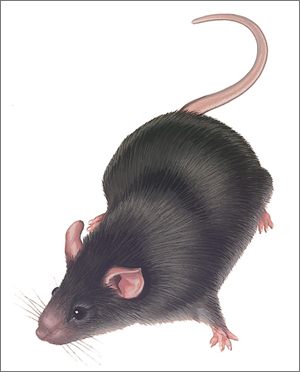Model Organism Week: EEK! The Mouse.
by
 The mouse has been used for years as a model vertebrate organism and as such has allowed for not only groundbreaking work in the basic sciences but also the development of treatments, as well as cures, for many notorious diseases.
The mouse has been used for years as a model vertebrate organism and as such has allowed for not only groundbreaking work in the basic sciences but also the development of treatments, as well as cures, for many notorious diseases.
Fruit flies and bacteria make excellent model organisms for genetics and developmental biology due to their large population sizes and extremely rapid life cycles. However, it would be impossible to develop a fruit fly or bacterial model of heart disease, stroke, obesity, or even learning and memory that would be directly applicable to humans. Thankfully we do have animal models of these processes as well as many others due to the strikingly uncanny similarities of man and mouse.
As biomedical research has continued to expand and evolve, an ever increasing demand has been placed on the development of animal models for various human afflictions and the mouse has been the number one choice. In 2007, Dr. Sawa of Johns Hopkins developed the first animal model of schizophrenia through selective mutations of the DISC1 gene2. Just like in humans, the anatomical hallmarks of schizophrenia such as enlarged ventricles were present as were the behavioral hallmarks of apathy, confusion, and sensory motor difficulties. Just one year later in 2008, Dr. Seyfried of Boston College developed the first successful animal model of metastasis, the process by which cancerous cells from one area of the body pass through the blood to another and begin the growth of a new tumor1. By injecting cancerous cells into otherwise healthy mice, Dr. Seyfried and his colleagues have been able to examine in excruciating detail the process of metastasis and potential treatments. These are certainly only a glimpse of the mouse’s role in biomedical research. Simply typing “mouse model” into PubMed queries nearly 130,000 entries.
I myself am a first-year graduate student at the University of Vermont and have begun to regularly use mice in an olfaction lab. By removing one of the few olfactory structures such as the main olfactory epithelium or the vomeronasal organ, patch-clamping and histochemical procedures can be undertaken to observe natural electrical phenomena, as well as, their potential modulators. This leads me to a final but important point: it would be wrong to assume that everything studied in the mouse is applicable to humans no matter how versatile it is and how many mouse models of disease there are. For example, the mouse’s vomeronasal organ has long been known to transduce pheromone signals and produce measurable effects on the animal’s behaviors. As far as the consensus is concerned, humans don’t have a functional vomeronasal organ! Therefore, any working mouse model of pheromonal effects in the vomeronasal organ is simply that and does not directly apply to humans.
To summarize, here is a concise list of some pros and cons of using mice as model vertebrate organisms:
Pros:
- Genetic and physiological similarities to humans allows for the generation of disease and treatment models.
- Entire genome sequenced- allows for the generation of specific mutant lineages and reverse genetics studies.
Cons:
- No animal model is ever perfect and there are still many irreconcilable differences between mice and humans.
- Draws negative attention from animal rights activists (i.e. PETA) and can be considered immoral in some social circles.
- Can be expensive to house and maintain
_____________________________________________________________________________________
Jon is a graduate student of Biology in his 1st year of grad school at the University of Vermont. When he’s not in the lab working with mice he enjoys listening to music, playing guitar, and exploring the outdoors.
_____________________________________________________________________________________
1Huysentruyt, L.C. et al. 2008. Metastatic cancer cells with macrophage properties: evidence from a new murine tumor model. International Journal of Cancer 123(1): 73–84.
2Hikida, T. et al. 2007. Dominant-negative DISC1 transgenic mice display schizophrenia-associated phenotypes detected by measures translatable to humans. PNAS 104(36): 14501-14506.
_____________________________________________________________________________________
See other articles in the series:
Drosophila melanogaster- The fruit fly.
Research’s Next Top Model (Zebrafish)
Getting to Know Your Worms (C. elegans)
Saccharomyces cerevisiae a.k.a Budding/Baker’s/Brewer’s Yeast
The Almighty Fungi: The Revolutionary Neurospora crassa
We’re Gonna Need a Bigger Lab: Large Animal Models in Research
Tetrahymena: Little Creature, Big Discoveries
.
.


Almaza Yaghmour
wrote on January 15, 2010 at 7:13 pm
Guess we need to find a new vertebrate organism then Dr. Vick…..
mandibula
wrote on February 15, 2010 at 12:50 pm
you know those are photos of rats, right? lol
alan@benchfly
wrote on February 15, 2010 at 7:16 pm
Hahaha- minor detail… Noted and fixed! Thanks!
Drosophila melanogaster: The Fruit Fly | BenchFly Blog
wrote on May 24, 2010 at 11:04 am
[…] EEK! The Mouse. […]
Model Organism Week: Tetrahymena - Little Creature, Big Discoveries | BenchFly Blog - Advice for Your Life in Science
wrote on June 16, 2010 at 10:32 pm
[…] EEK! The Mouse. […]